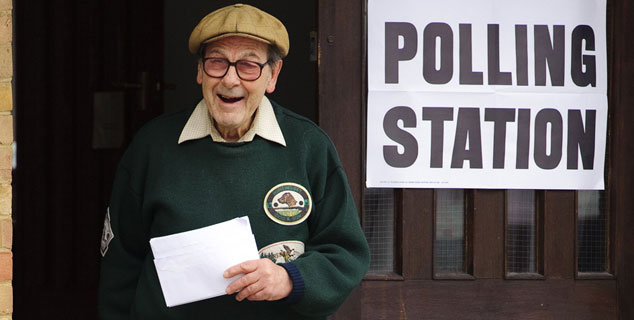
Austerity has hurt the young – and the pain could be about to get worse. But pensioners have been cosseted. Why? Simon Wilson reports.
What’s happened?
Real incomes for those aged 22-59 are still lower than they were before the financial crisis of 2007-2008, research published this week by the Institute for Fiscal Studies think tank reveals, and the only age group to have seen a real increase in incomes is the over-60s.
The survey has once again focused attention on the question of intergenerational fairness and inequality – the thesis that the post-war “baby boom” generation has enjoyed all kinds of structural advantages (free higher education or paid apprenticeships, secure working contracts and gold-plated final-salary pension schemes, as well as a stunning long-run housing boom) and it is now the job of policy-makers to try to adjust the balance in favour of today’s disadvantaged younger generations.
Haven’t pensioners always been richer?
Yes, in terms of assets. But not in terms of income – until recently. An analysis carried out last month by the Financial Times of 50 years’ worth of UK income data found that, over the past 35 years, average 20-somethings have seen their living standards (defined as income after housing costs) slip from a position of relative affluence (better off than 60% of the population) to well below par (better off than only 37% of the population).
By contrast, the average pensioner has enjoyed a rapid rise up the league tables. Those in the 65-70 age bracket used to have lower living standards than 75% of UK households; now they can expect to be almost in the top 40%.
How have coalition policies affected the situation?
In much the same way that UK politicians seem to regard the NHS with quasi-religious reverence, the coalition has treated the nation’s elderly with astonishing fiscal obeisance. Since 2010 the basic state pension has risen by 16% (a real-terms rise of 5%) thanks to the generous “triple-lock” formula (a Lib Dem policy that both the Tories and Labour are now committed to) that guarantees pensioners an annual rise of whichever is highest: price inflation, wage inflation, or 2.5%.
In addition, the government now also subsidises pensioners’ savings, by selling bonds yielding 4% (that is more than five times the government’s current borrowing cost) solely to the over-65s. Then, of course, there are the icing-on-the-cake universal benefits, such as free TV licences, free bus travel and the winter fuel allowance.
What about younger generations?
The average two-pensioner household has seen its income fall by £23 over this parliament as the result of coalition tax hikes and spending cuts; but the average household has taken a hit of £500. Even as state pensions rise, average wages and working-age benefits have fallen. Child benefit, once a universal payment to parents, is now means-tested.
And while the Conservatives have vowed to protect pensioners’ handouts, they have promised the young even more austerity, by making them work for unemployment benefits (which are already 21% less generous for the under-25s) and denying them housing benefit. In sum, coalition policies have worsened, rather than alleviated, intergenerational inequalities.
What’s the government’s thinking?
That older people are more likely to vote Tory. A fortnight ago, David Cameron vowed that pensioners’ handouts would be protected on the grounds that “these people have fought wars, seen us through recessions; made this the great country it is today”. While this analysis might be poetic, it is also fiscally reckless and morally questionable – as well as inaccurate.
Far from being the uncomplaining war veterans of the Tory imagination, argues The Economist, these oldies typically “came of age in the easy-living 1960s. Buoyed by generous pensions and decades of soaring house prices, the wealthiest fifth of pensioner households enjoy average incomes well over twice the British average: for such lucky wrinklies, the winter-fuel allowance is less an inducement to turn on the radiator than an invitation to chambrer some decent wine.”
What should policy-makers do?
They should, of course, be careful of getting into the territory of “blaming the baby boomers” for “stealing” their children’s future. After all, the house-price boom was not the “fault” of
a particular generation. And not all old people are wealthy; some are very poor indeed, and more are still in paid work than ever before. But the UK’s politicians will at some point have to start coming up with policies that at least address the issue, rather than knowingly make it worse.
As a House of Lords report into the subject put it: “It does not seem fair to expect today’s younger taxpayers – especially those not born to better-off parents – to pay more for the increased costs of an older society while asset-rich older people (and their children) are protected.”
The death of homeownership
In the space of just one decade, the proportion of people aged 25-34 who own their own house has slid from almost two thirds in 2003-2004, to little over a third (36%) in 2014. Almost half of that age group now rents from private landlords. By contrast, at the other end of the “property ladder” – that obsolescent metaphor for the accumulation of wealth through one’s lifetime – the number of asset-rich households who own their principal residence outright without a mortgage has grown rapidly, to 7.4 million.
For the first time the number of mortgage-free homeowners now exceeds the number paying a mortgage (6.9 million). All of these figures suggest a society set for a more insecure, unstable and unequal future, as home ownership becomes the preserve of the richer and older.